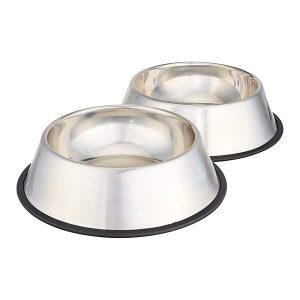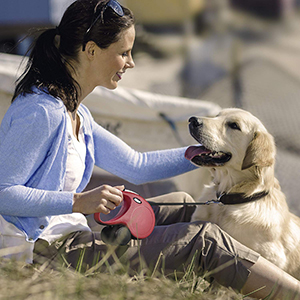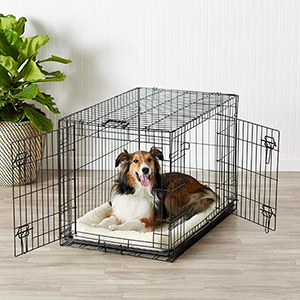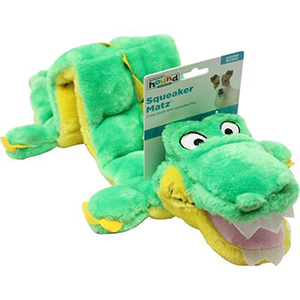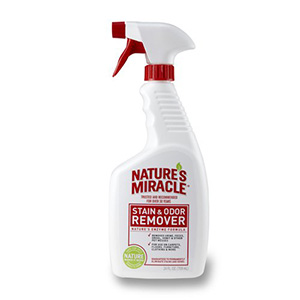Dogs get worms when they ingest something that is contaminated with the parasite, such as infected rodents or animal feces. There are many different kinds of worms dogs can get, including heartworms, roundworms and tapeworms. Worms can cause serious illnesses in dogs, but infection is preventable in many cases.
Learn what you can do as a pet parent to keep your dog from developing worms.
Worms are internal parasites that can cause serious health problems in dogs. If left untreated, they can cause serious disease and even death in your pet. Some worms can even be transferred from pets to humans. Fortunately, parasites are treatable and preventable.
Learn more about the different types of parasites dogs can get, how to tell if your dog has worms, how to treat intestinal parasites in dogs and how to prevent your dog from getting worms.
Types of Worms and How to Identify Them
There are many types of worms dogs can get from parasites. Some of the most common are roundworms, tapeworms, hookworms, whipworms and heartworms.
Heartworms
Heartworms are passed to dogs through mosquitoes infected with the parasite Dirofilaria immitis. Once inside the dog, the parasite can mature into worms, which then travel to the dog’s heart where they may grow large enough to restrict blood flow to the heart and lungs, resulting in death.
How to identify heartworms in your dog: Heartworms can be asymptomatic, especially in its early stages. Six to eight months after infection is when most dogs begin showing symptoms, which may include coughing, fatigue, decreased appetite, weight loss, fluid in the abdomen or heart failure. If you notice any of these symptoms in your dog, contact your local veterinarian right away.
Roundworms
Roundworms, also called ascarids, are transmitted to dogs that eat infected soil or stool, or infected rodents. Ascarid eggs found within the contaminated matter travel into the dog’s intestines where they hatch and develop into mature worms; these mature worms then lay their own eggs. Those eggs are released through the dog’s stool while the worms remain inside the dog, repeating the cycle. Humans can become infected with roundworms by ingesting their eggs.
How to identify roundworms in your dog: Roundworms in a dog’s stool can be off-white or tan in color and spaghetti-like in appearance. Your dog may also exhibit signs of infection such as weight loss, diarrhea, mucous or blood-flecked stool, vomiting, fluid in the abdomen and poor coat quality. As a best practice, always examine your dog’s stool when you pick it up. The earlier you catch a worm infection, the better.
Tapeworms
Most tapeworms are not passed from pet to pet, but rather from an infected flea or rodent. Once inside their new host, tapeworms will live in the intestines and lay eggs to reproduce. Worm segments containing eggs are shed through the dog’s stool, but the heads of the tapeworms remain intact inside the dog’s intestines to grow new segments and continue the process.
How to identify tapeworms in your dog: Tapeworms may be visible in your dog’s stool or clinging to hair around the anal area. Fresh tapeworms will be white and a quarter- to half-inch long; dry tapeworms will resemble sesame seeds or grains of rice.
Hookworms
Hookworms are internal parasites that can infect both animals and humans. Dogs can become infected by ingesting contaminated matter, such as soil or stool, as well as by larval entry through the skin.
Once inside their host, hookworms consume a significant amount of blood and lay eggs inside the intestinal tract, which pass into the stool and develop into larvae. Humans can become infected with hookworms through contact with the skin, usually on the feet.
How to identify hookworms in your dog: Hookworms are too small to be seen by the naked eye. A microscopic examination of a dog’s stool is the only way to diagnose a hookworm infection. Signs of infection in your dog might include diarrhea, weight loss, poor coat quality, dehydration and pale mucous membranes.
Since humans can get hookworms without ingesting them, talk with your veterinarian and physician if your dog becomes infected.
Whipworms
Like other internal parasites, whipworms enter dogs by the ingestion of soil or stool contaminated with whipworm eggs. Once inside a dog, the whipworms will live in the large intestine and reproduce by laying eggs, which are then passed to the stool.
How to identify whipworms in your dog: As with hookworms, whipworms must be identified through a microscopic examination of the stool. Signs of infection may include diarrhea, weight loss, blood-tinged or mucous-covered stools.
How to Treat and Prevent Worms in Dogs
Identifying and Treating Worms in Dogs
If you believe your dog may have worms, make an appointment with your veterinarian as soon as possible. Your vet will do a stool examination to determine if worms are present. If your dog has worms, your veterinarian will prescribe an appropriate medication and treatment plan depending on the type of worms your dog has.
Roundworms, for example, require two dewormings 10-21 days apart, whereas hookworm treatment may include hospitalization and administration of fluids if significant blood loss or dehydration has occurred. Many intestinal parasites are not effectively treated with over-the-counter dewormers, so it’s best to take your dog to the vet for a prescription dog worms treatment.
While worms are most often found in puppies, they can infect dogs of any age. Keep in mind that normal bowel movements do not necessarily mean there is no infection. If your dog is exhibiting any unusual symptoms, make an appointment with your veterinarian.
Preventing Worms in Dogs
Treat Your Yard
Parasites can infect dogs year-round, but as the weather warms and dogs spend more time outside, the risk of exposure to parasites rises. Fleas, ticks and mosquitoes – all potential parasite carriers – are found more frequently in the summer. Treating your yard to keep these pests at bay is an important step in preventing your dog from getting worms.
Give Preventive Medicine
You should treat your pet with routine flea and tick preventives. Ask your veterinarian for recommendations on the best flea and tick prevention medication for your dog. Administering routine dewormer medication can also help keep your dog from getting worms. There are many different types and forms of dewormer, and choosing the best dewormer for your dog is something your veterinarian can help with. Some dogs may need an injectable medication, while others can take a liquid or pill form. Dosing can depend on several factors such as your dog’s age and weight.
Visit Your Veterinarian
Finally, scheduling routine veterinary examinations and stool analyses for your dog can help identify the presence of parasites or worms sooner so you can administer treatment before the infestation becomes serious. Most dogs should have two annual exams, but your veterinarian may prescribe them more frequently if your dog has a history of parasite infection.















